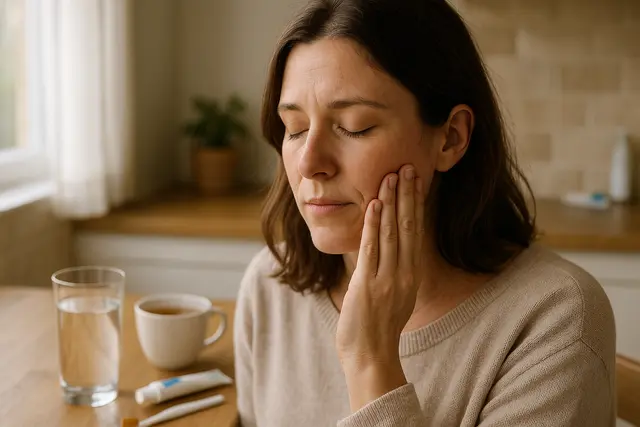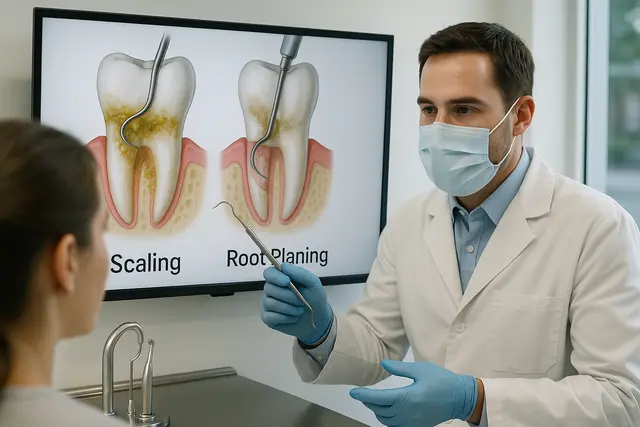General Dentistry
7 min read
Jun 04, 2025
Black Stuff on Teeth After Filling: What It Means and What to Do
Ever noticed a black spot on your tooth after getting a filling and thought, “Wait, was that always there?” You’re not alone. It’s a common concern, and one that can leave you wondering if something went wrong or if your tooth is playing tricks on you.

Let’s set the scene. You’ve done the right thing. You showed up to your dental appointment (gold star), had a cavity handled, and walked out with a brand new filling. But then, days or weeks later, you spot it, a black spot near the tooth. Maybe around the filling. Maybe on the edge. Cue the panic spiral: Did something go wrong? Is it infected? Am I rotting from the inside out?
Before you start Googling “tooth extraction horror stories,” take a breath. That mysterious black stuff on your tooth after a filling? It might not be as scary as it looks, but it’s definitely something worth paying attention to. Let’s talk about what’s going on, what’s normal, and when you should pick up the phone and call your dentist.
The Tooth Behind the Trouble
To understand what that black spot is, it helps to know a bit about the tooth itself. Your teeth are made of layers, with the outer layer being tooth enamel, the hard, shiny part that’s supposed to keep everything else safe. Beneath that is dentin, and then the pulp, which houses nerves and blood vessels. When a cavity happens, bacteria have essentially partied too hard and eaten through your enamel. That’s where a filling comes in, to patch up the damage and keep the party crashers out.
Filling in the Gaps (Literally)
A filling is used to restore a tooth that’s been damaged by decay. The most common types are composite (a tooth-colored material), amalgam (the classic silver filling), porcelain, or even gold if you’re feeling extra. Composite fillings are popular because they blend in with your natural teeth. Amalgam fillings, still reliable, have that silvery tone and have been known to turn black or dark grey over time. That alone might explain what you’re seeing.
Sometimes, the black spot isn’t even on the filling but next to it or around the edges. That’s where things get interesting, and occasionally tricky.
Dental Red Flags You Shouldn't Ignore
A black spot on your tooth doesn’t always mean you need to run screaming into the night, but it can be a warning sign. Here’s what it might mean:
Residual Stain or Shadow
If your dentist used a silver filling or even a composite resin with staining agents nearby, it can look like a dark spot. Sometimes food and drinks can stain the area near the filling. Coffee, wine, tea, they don’t just stain teeth; they can discolor a new filling too. Especially if your oral hygiene hasn’t been at its best (no judgment, we’ve all skipped a night of brushing).
Stain in the Filling Material
Composite fillings, though versatile, can discolor over time. A filling may appear black if it’s been absorbing pigments from food or if it wasn’t properly sealed. That’s why some fillings turn black or develop a faint black line along the edges.
Tooth Decay That’s Come Back
Yes, decay can sneak back in underneath the filling or around the filling if bacteria find a way in. If you notice the black spot getting bigger, or you feel any tooth sensitivity or pain when you chew, it could be new decay taking root. A filled tooth isn’t immune forever.
Tartar Buildup or Plaque
Poor brushing and flossing habits can lead to tartar, a hardened layer of plaque that traps stains and bacteria. It can look like black spots on teeth, especially near the gumline or between teeth and fillings.
A Cavity That Wasn’t Fully Cleaned Out
It’s rare, but if the decayed portion of the tooth wasn’t completely removed before the filling was placed, that decay can darken over time and become visible through the enamel or the filling.
That Mysterious Black Spot on Your Tooth
Let’s tackle the most Googled panic: “Why is there a black spot on my tooth after a filling?” Here’s the short answer, it could be stain, decay, or just normal discoloration from the dental material used. But here’s the part that matters: it shouldn’t be ignored, especially if it’s new, growing, or painful.
Your teeth and gums are great at letting you know when something’s off. If you feel a twinge when you drink something cold, or you notice a weird taste, or the spot turns from black to brown or gray, don’t wait for your next regular dental visit. Make an earlier appointment with your dentist and have them take a look.
What Causes Black?
In short, a lot of things. Here’s a quick breakdown of what causes black or dark spots near or on a filling:
Silver or amalgam filling aging
Composite resin staining
Tooth enamel thinning
Residual decay
Plaque or tartar deposits
Metal leaching from older restorations
New decay sneaking in at the edges of the filling
Black stains on teeth aren’t always about poor brushing, but maintaining good oral hygiene really does help prevent many of these issues.
The Turn Black Moment: Is It Serious?
If a filling starts to turn black, that’s not a great sign. It may mean the composite material is degrading or that decay has crept back in. If you’ve got a new filling that suddenly looks sketchy, or if the edges of the filling feel rough or uneven, that could be a sign of breakdown.
Composite fillings are designed to blend in, but if they start changing color, it’s time for a chat with your dental professional. Same goes for a silver filling that’s gone black or started to stain nearby tooth structure. That could be leaching or corrosion.
Tooth Filling Gone Dark? Here’s What to Do
Don’t panic, but don’t brush it off either (pun absolutely intended). Here’s your plan:
Step 1: Keep up with brushing and flossing like a champ. Twice a day brushing, once a day flossing, no shortcuts. Use a soft-bristled brush and fluoride toothpaste.
Step 2: Cut back on foods and drinks that stain teeth. That includes red wine, coffee, tea, soda, and dark berries. Rinse with water after eating if you can’t brush.
Step 3: Schedule a dental check-up if the spot doesn’t fade, grows larger, or you feel discomfort.
Step 4: Ask your dentist if the filling material might be the cause. Sometimes, swapping a stained composite for a fresh white material can do the trick.
Dental Care Isn’t Just for Emergencies
It’s easy to forget, but regular dental check-ups and routine dental cleanings aren’t just box-ticking exercises. They can help catch minor issues before they snowball. Dark spots, black lines, or odd discoloration can be caught and handled fast, avoiding bigger problems like tooth extraction or crown replacement later.
Even the healthiest natural teeth can develop stains. But if the stain is on a posterior tooth (a back molar), it’s often easier to miss until it becomes a bigger issue. That’s where your regular dental routine shines, literally and figuratively.
When Fillings Cause More Than They Fix
Most fillings are problem-solvers, not troublemakers. But sometimes, fillings can lead to problems, especially if they crack, chip, or leak. A tiny gap can let bacteria back in, causing new decay or even a painful infection. That’s why noticing a black spot on your tooth early matters.
If your filling may be causing the issue, your dentist might polish it, replace it, or in some cases, recommend a dental crown for added protection. Crowns are like little helmets for your teeth and are especially useful for teeth damaged by decay or wear and tear.
Are White Fillings Safe from Staining?
We wish. White fillings, also called composite fillings, do a great job of mimicking natural enamel, but they’re not immune to staining. Composite resin can pick up pigment from everything from tomato sauce to tobacco. Still, they’re less likely to turn black than older amalgam options. If you’re concerned about looks, especially on front teeth, ask your dentist about porcelain alternatives.
Final Words
Let’s wrap this up the way your dentist would, with honesty and some helpful advice. A black spot on your tooth after a filling isn’t always a sign of doom. Sometimes it’s a stain. Sometimes it’s a signal that something needs a closer look. Either way, ignoring it isn’t the move.
Your best defense? Keep brushing and flossing, show up for your dental visits, and if you ever think, “hmm, that spot looks darker than yesterday,” see your dentist. That one choice can prevent tooth decay, protect your tooth structure, and help you smile with confidence, without wondering if your tooth is hiding a secret.
And hey, if you do need a touch-up or replacement? No shame in that. Teeth go through a lot, and your fillings are doing their best. With a little help and the right care, your smile can stay bright, healthy, and gloriously black-spot-free.
Why Is There a Black Spot on My Tooth After a Filling?
A black spot after a filling can be caused by staining from food or drink, discoloration of the filling material, residual decay, or tartar buildup. It might also result from the type of material used, amalgam fillings can darken over time. While it’s not always serious, it should be checked by your dentist to rule out new decay or filling failure.
Is a Dark Spot on or Near a Filling a Sign of New Decay?
It could be. If bacteria find a way beneath or around the edges of the filling, decay can develop again. Signs to watch for include the spot growing in size, changes in color, increased sensitivity, or discomfort when chewing. If you notice any of these symptoms, contact your dentist promptly for evaluation.
Can White (Composite) Fillings Turn Black Over Time?
Yes, composite fillings can discolor from staining agents like coffee, tea, red wine, or tobacco. If the material wasn’t sealed properly or has degraded over time, it may develop dark spots. Though less common than with silver fillings, it’s still important to monitor any changes in appearance.
What Should I Do If I Notice a Black Spot on a Filled Tooth?
Start by maintaining excellent oral hygiene, brush twice a day, floss daily, and avoid heavily pigmented foods. If the spot doesn’t fade, grows larger, or you experience pain or sensitivity, schedule a dental visit. Your dentist may polish the filling, replace it, or recommend additional treatment if decay is present.
Read Next
Related Posts

General Dentistry
How to Stop Nerve Pain in Tooth: Fast Relief That Works
Tooth nerve pain can be one of the most intense and disruptive types of discomfort. It often strikes without warning and makes everyday activities like eating, drinking, or even talking feel unbearable. Understanding what causes this pain and how to manage it effectively is key to getting fast relief.
4 min read
Sep 15, 2025

General Dentistry
Can a Sinus Infection Make Your Jaw Hurt? Understanding the Connection
Jaw pain can be unsettling, especially when it seems to appear out of nowhere alongside a stuffy nose or headache. Many people are surprised to learn that sinus infections can cause discomfort that feels like it’s coming from the jaw. Understanding the connection between your sinuses and jaw pain is key to getting the right treatment.
5 min read
Sep 15, 2025

General Dentistry
What Is SRP in Dentistry? A Complete Guide to Scaling and Root Planing
When it comes to dental health, most people think regular cleanings are enough to keep their smile safe. But sometimes, what’s happening below the gumline needs more attention. Scaling and root planing (SRP) is a treatment designed to address gum disease at its source, protecting both your gums and teeth from long-term damage.
5 min read
Sep 10, 2025
Don’t have time to research every dentist around you?
See why 30k+ patients trusted us